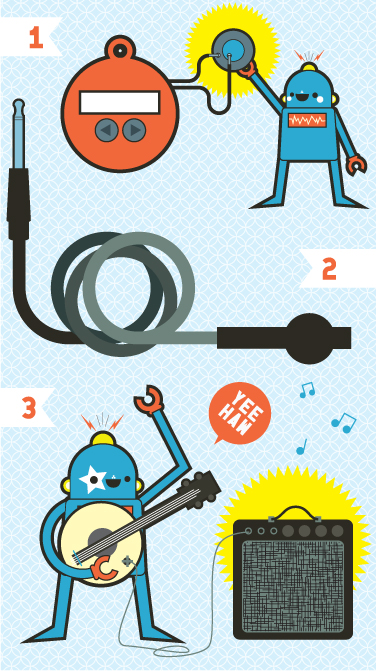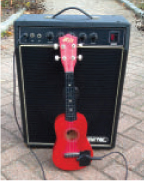123 Piezo Contact Mic
Written and photographed by Justin Emerson ![]() Illustrations by Julie West
Illustrations by Julie West



A CONTACT MICROPHONE IS A SMALL DEVICE THAT CAN BE USED TO AMPLIFY ACOUSTIC INSTRUMENTS. You don’t sing or talk into a contact mic. As the name implies, it makes contact with a solid object and turns mechanical vibrations into electricity. Because a contact mic doesn't pick up ambient sounds in the room, it focuses in on one instrument without interference or feedback.
1. Aquire parts
Gather old toys from the attic or the thrift store and pull out the blippity bleepy ones. Open them up to see if they have a piezoelectric disc or a normal speaker. Hopefully you'll find some piezos. You will need to break apart some plastic bits to get at them — just be careful not to damage the discs.
2. Wire it up
Cut the audio cable in half. Now you have enough cable and connectors for two contact mics! Strip off a bit of outer insulation from the cut end of the audio cable. Strip and tin the signal and ground wires. Desolder the two piezo wires where they connect to the piezo. Now solder the signal and ground wires from your audio cable to those same points on the piezo. Dab some hot glue on the back of the piezo, for strength. Test it by plugging the cable into a low-powered amp and tapping on the piezo. You should hear the sound of the amplified tapping.
3. Finish it up
Use heat-shrink tubing, electrical tape, Plasti Dip, or epoxy to insulate the wires, the solder connections, and the piezo itself. Use gaffer’s tape to attach the mic to different objects like cardboard boxes and paper cups, and acoustic instruments like guitars and kalimbas. You may get a feedback loop if the mic is too close to the amp; not necessarily a bad thing if you’re a noise artist. Effects pedals can be used to flavor the sound to your taste. ![]()

JUSTIN EMERSON makes experimental electronic music with hand-built and modified instruments. His band, Burnkit2600 (burnkit2600.com), performs and gives workshops and presentations on the topics of circuit bending, chiptune, and DIY electronics.

You will need:
» Piezo disc
» Audio cable such as a ¼" guitar cable
» Low-powered practice amp
» Heat-shrink tubing wide enough to fit over the piezo
» Gaffer’s tape
» Soldering iron and solder
» Wire cutter / stipper
» Screwdriver, small
» Heat gun or hair dryer
» Hot glue gun and glue
+ Superpower your project by building a preamplifier circuit for your piezo: makezine.com/micpreamp.
